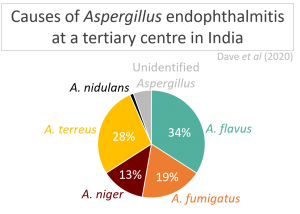Submitted by Aspergillus Administrator on 23 September 2008

Hurricane Ike swept through the US state of Ohio last week just as fields of grain were ripening.
This article discusses the damage done by the storm to crops and the potential for infection by Aspergillus.
The most severe damage seem to be done to crops stressed by drought which collapse to the ground when blown by severe winds.
The plant is therefore already vulnerable to infection, presumably because there are already several dead leaves on the plant due to early growth dying back when little water is available. All that is needed is sufficient moisture and direct contact with spores – both of which happen if lying on moist soil.
The next immediate threat is from mycotoxins – toxic chemicals produced by Aspergillus and other fungi which will make the crop inedible. There are specific conditions required before the infecting fungus can produce mycotoxins (e.g.
Aflatoxin) which are mentioned in the article:
Aspergillus can infect grain and produce aflatoxin under a wide range of conditions: temperature between 54 degrees and 108 degrees Fahrenheit; kernel moisture between 15 percent and 25 percent; and relative humidity above 80 percent.
“Downed corn will certainly be exposed to these conditions, especially high moisture if it rains, and since aspergillus is a soil-borne fungus infection could easily occur,” said Paul.
But, he added, growers should also pay attention to such ear mold diseases as fusarium and diplodia, which could develop if damaged ears come in contact with moist soils.
Any condition that increases moisture in the grain, puts maturing grain in contact with the soil, restricts drying, and makes harvest operation difficult could promote fungal growth and toxin contamination.
News archives
Showing 10 posts of 953 posts found.



